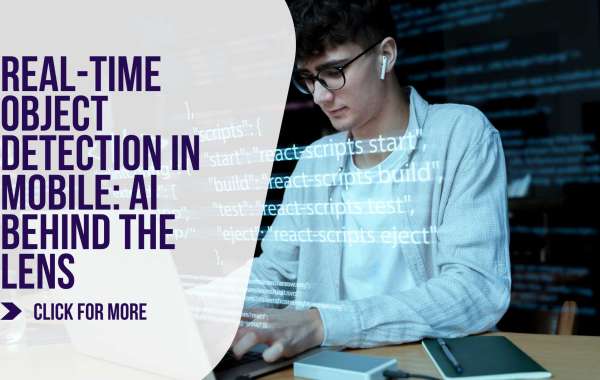In the realm of mobile apps, real-time object detection is one of the most exciting innovations. Imagine a world where your smartphone or tablet not only captures a moment but also understands what it sees, reacts to it, and even takes action. This is not science fiction—it's happening today, thanks to the power of Artificial Intelligence (AI) and machine learning (ML). But how does real-time object detection work in mobile devices, and what does it mean for app development?
Let’s take a closer look.
Understanding Object Detection: The Basics
Before we dive into the role of AI in mobile devices, it’s essential to first grasp what object detection is. At its core, object detection is a computer vision technique that enables software to identify and classify objects within images or videos. It’s not just about recognizing a cat or a car; it’s about pinpointing exact locations of objects, tracking them over time, and even interpreting the relationships between them.
Real-time object detection is exactly what it sounds like: the ability to identify and classify objects instantly, often as the camera is actively recording. This capability has profound implications for the way we interact with our devices and the world around us. But how does this technology actually work, and what powers it?
The Role of AI in Object Detection
To power real-time object detection, AI must do several things at once: it needs to understand an image, recognize various objects, and do all of this in real-time, without significant lag. So, how does AI make this possible?
It begins with deep learning, a subset of machine learning. Deep learning models are trained on massive datasets, often containing millions of labeled images, to recognize patterns and relationships. Convolutional Neural Networks (CNNs), for instance, are the backbone of most modern object detection models. CNNs are particularly adept at processing images and detecting spatial hierarchies—meaning they can detect features like edges, shapes, and textures within an image, and then combine those to identify complex objects.
AI doesn’t just stop at recognizing objects, though. With the help of sophisticated algorithms, it can also track these objects across video frames, make predictions about where they’re headed, and even identify new objects as they appear in the scene.
Real-Time Object Detection on Mobile Devices: The Challenges
Real-time object detection is a complex process. On top of needing fast and accurate AI, there are challenges in running such computationally intensive tasks on mobile devices, which are limited by hardware and battery life.
First, mobile processors are significantly less powerful than desktop or server processors. While smartphones have come a long way in terms of processing power, they still face limitations. The task of running a neural network, especially one used for object detection, requires a lot of computing power, memory, and energy. This makes it a challenge to perform real-time detection without causing a performance hit or draining the battery too quickly.
Second, the need for rapid processing poses a challenge for maintaining a smooth user experience. When you’re working with video feeds or live camera streams, lag can ruin the whole interaction. Whether you’re using AR (augmented reality) to navigate a new city or an app to analyze products in a store, delays in object detection are unacceptable.
Finally, real-time object detection needs to be as accurate as possible, with minimal false positives. When you point your phone camera at an object, the app should identify it correctly, without confusing a cup for a ball or misidentifying a person’s face as something else. This requires a deep understanding of the context, and that’s where AI-powered solutions shine.
How AI Makes Real-Time Object Detection Feasible on Mobile
Here’s where things get interesting. The breakthroughs in AI technology, combined with advancements in mobile hardware, have made real-time object detection feasible in mobile apps. Mobile devices now feature powerful processors, specialized chips like Apple’s Neural Engine and Qualcomm’s Hexagon DSP (digital signal processor), which are designed specifically to run AI models more efficiently.
Edge computing plays a key role here. Instead of sending all data to cloud servers for processing, edge computing allows the device itself to process the data locally. This reduces latency and makes the detection process faster and more efficient. Local processing also saves on bandwidth, as the data doesn’t have to be transmitted to a remote server and back.
On-device machine learning is another breakthrough. Many modern smartphones now come equipped with dedicated AI chips and frameworks like TensorFlow Lite or Core ML that enable on-device machine learning. These frameworks are designed to run optimized models directly on the mobile device, making real-time object detection not only possible but also efficient.
Additionally, mobile apps can take advantage of optimized computer vision models that are designed to work with mobile hardware constraints. Instead of using large, resource-hungry models, developers can use lighter versions that are still highly accurate but require less processing power.
Real-World Applications of Real-Time Object Detection
Now that we’ve explored how AI powers real-time object detection, let’s look at some real-world applications that showcase its transformative potential.
Augmented Reality (AR): One of the most visible uses of real-time object detection is in augmented reality apps. AR applications, like those used in gaming (think Pokémon Go) or retail (like IKEA Place), rely heavily on real-time object detection to place virtual objects in the real world. These apps need to instantly identify flat surfaces, walls, and objects in the real world, so they can render virtual elements in the right context.
Retail and Shopping Apps: Many retail apps are now incorporating object detection features, allowing users to scan items and instantly retrieve information like product details, reviews, and pricing. Imagine walking into a store and using your phone to scan a product to get all the information you need, without even having to ask a salesperson.
Health and Fitness Apps: Real-time object detection can also be used in health and fitness apps. For example, apps can detect and track a person’s movements during exercise, offering feedback on form and technique. This type of AI-powered feedback could revolutionize how we approach fitness, making personalized training accessible to anyone with a smartphone.
Security and Surveillance: Mobile devices are also being used for security purposes. Real-time object detection can help identify faces or detect unusual activity in security camera feeds. Apps that monitor live surveillance footage can use this technology to alert users to potential threats, improving security without requiring extensive human oversight.
Driver Assistance and Autonomous Vehicles: Object detection also plays a pivotal role in mobile apps for driver assistance and autonomous vehicles. These apps use AI to detect pedestrians, other vehicles, traffic signs, and obstacles in real-time to ensure a safe driving experience.
Interactive Gaming: The gaming world, especially in AR and mixed-reality games, has embraced object detection. Games like Pokémon Go require real-time detection to place virtual creatures in the real-world environment as users move around, offering a truly immersive experience.
The Future of Real-Time Object Detection in Mobile
The future of real-time object detection on mobile apps looks incredibly promising. With AI continuing to evolve, these systems will become even faster, more accurate, and capable of handling more complex tasks. In the near future, we can expect real-time object detection to integrate seamlessly into more applications, enhancing user experiences across a variety of industries.
With 5G networks rolling out across the globe, we can expect an even greater shift in how mobile apps leverage real-time object detection. The increased bandwidth will allow mobile devices to access even larger datasets, enabling apps to make smarter decisions based on a more extensive context.
Furthermore, advancements in 3D object recognition, multimodal AI (combining vision, sound, and touch), and context-aware systems will allow mobile apps to offer even more personalized and intelligent services. For example, mobile apps may soon be able to understand the surrounding environment at an even more granular level, offering real-time insights or interactions based on precise object detection and contextual awareness.
Conclusion
Real-time object detection in mobile apps is an exciting frontier in AI technology, offering a new way to interact with the world around us. Through the power of machine learning, edge computing, and optimized mobile hardware, we are now able to recognize, classify, and track objects in real-time—all from the palm of our hand. Whether it’s for gaming, retail, security, or fitness, this technology is already revolutionizing the way we use our smartphones.
As mobile app development continues to evolve, the role of AI and real-time object detection will only become more significant. If you’re considering building a mobile app with cutting-edge capabilities like real-time object detection, collaborating with experts who specialize in mobile app development in Atlanta could provide the innovative solutions you need to stay ahead in today’s competitive tech landscape.





